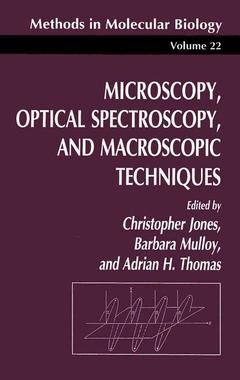Description
Microscopy, Optical Spectroscopy, and Macroscopic Techniques, 1994
Methods in Molecular Biology Series, Vol. 22
Authors: Jones Christopher, Mulloy Barbara, Thomas Adrian H.
Language: English
Subject for Microscopy, Optical Spectroscopy, and Macroscopic Techniques:
105.49 €
In Print (Delivery period: 15 days).
Add to cart
Publication date: 08-2013
251 p. · 15.2x22.9 cm · Paperback
251 p. · 15.2x22.9 cm · Paperback
Description
/li>Contents
/li>
This is the second of three volumes of Methods in Molecular Biology that deal with Physical Methods of Analysis. The first of these, Spectroscopic Methods and Analyses dealt with NMR spec troscopy, mass spectrometry, and metalloprotein techniques, and the third will cover X-ray crystallographic methods. As with the first volume. Microscopy, Optical Spectroscopy, and Macroscopic Techniques is intended to provide a basic understand ing for the biochemist or biologist who needs to collaborate with spe cialists in applying the techniques of modern physical chemistry to biological macromolecules. The methods treated in this book fall into four groups. Part One covers microscopy, which aims to visualize individual molecules or complexes of several molecules. Electron microscopy is the more familiar of these, while scanning tunneling microscopy is a new and rapidly developing tool. Methods for determining the shapes and sizes of molecules in solution are described in Part Two, which includes chapters on X-ray and neutron scattering, light scattering, and ult- centrifugation. Calorimetry, described in Part Three, provides the means to monitor processes involving thermodynamic changes, whether these are intramolecular, such as conformational transition, or the interactions between solutes or between a solute and its sol vent. Part Four is concerned with optical and infrared spectroscopy and describes applications ranging from the measurement of protein concentration by UV absorbance to the analysis of secondary struc ture using circular dichroism and Fourier-transform infrared spec troscopy.
Microscopy.- Electron Microscopy of Protein-Nucleic Acid Complexes.- Visualization of Unshadowed DNA by Electron Microscopy.- Biological Applications of Scanning Tunneling Microscopy.- Scattering And SedimentatioN.- High-Flux X-Ray and Neutron Solution Scattering.- Determination of Macromolecular Homogeneity, Shape, and Interactions Using Sedimentation Velocity Analytical Ultracentrifugation.- Determination of Absolute Molecular Weights Using Sedimentation Equilibrium Analytical Ultracentrifugation.- Classical Light Scattering for the Determination of Absolute Molecular Weights and Gross Conformation of Biological Macromolecules.- Determination of Diffusion Coefficients of Biological Macromolecules by Dynamic Light Scattering.- Calorimetric Methods.- to Microcalorimetry and Biomolecular Energetics.- Differential Scanning Calorimetry.- Isothermal Titration Microcalorimetry.- Optical Spectroscopy.- Optical Spectroscopy.- The Measurement of Electronic Absorption Spectra in the Ultraviolet and Visible.- Analysis of Polypeptide and Protein Structures Using Fourier Transform Infrared Spectroscopy.- Fluorescence Spectroscopy.- Circular Dichroism.
© 2024 LAVOISIER S.A.S.




